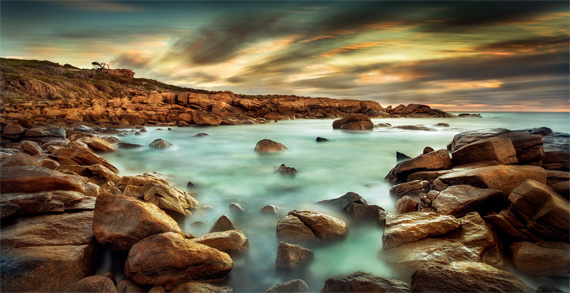Long Exposures look great but can be a little tricky to get the correct exposure. Sure there are Apps and charts to help out, but, what if there was an easier way?
A way that doesn’t require an App, doesn’t require a chart and most importantly doesn’t require taking your filters off to calculate the exposure length.

The easy way to perfectly calculate the exposure time for your long exposures every time!
Let’s get into it.
- Frame up your shot
- Place the filters you wish to use into your filter holder and onto the camera, ready to shoot
- Set your ISO to 6400
- Test shoot at ISO 6400 until you have the perfect Histogram
- Once you have the perfect histogram, take note of the exposure length.
- Set your camera back to ISO 100
- And now how many seconds exposure at ISO 6400 now equal minutes at ISO 100
Basically, with all your filters in place and your camera set to ISO 6400, if the perfect exposure was 1 second, once you switch back to ISO 100 your perfect Exposure will be 1 minute.
2.5 secs = 2.5 minutes
10 secs = 10 minutes
Once you have the perfect exposure at ISO 6400, you have the perfect exposure at ISO 100.
ISO 6400 Seconds = ISO 100 Minutes
Why? Basically, it comes down to ratios.
60 seconds in 1 minute = 64 ISO 100s in ISO 6400 – roughly the same ratio’s.
I guarantee this technique works perfectly in constant light. Go out at midday with your 10 stop filter and try out the ISO 6400 technique. I bet it works every time!
Just make sure you remember to switch back to ISO 100 before taking the Long Exposure!
Oh and remember to calculate the ISO 6400 seconds with your filters in place.
Long Exposure Tips
- Make sure when you are shooting LE’s that you cover up your rear viewfinder, a little light can sneak in there and ruin your Long Exposures.
- LE’s can be really tricky when the light is rapidly changing, like Sunset/Sunrise. My rule of thumb here is if you are shooting LE’s as the light is changing, you need to 1/2 your exposure time as the light is increasing at Sunrise and Double it as the light fades at Sunset.
- Use Bulb Mode to shoot LE’s longer than 30 seconds
Below is a video on the same technique.
The most likely time to damage or break your neutral density filters is taking them on and off your camera. Rather than take your filters off to calculate your exposure time, leave them on and use this simple super fast technique.
Like This Article?
Don't Miss The Next One!
Join over 100,000 photographers of all experience levels who receive our free photography tips and articles to stay current:







So how would you calculate if the lowest ISO setting your camera has is 200?
While Brian’s comments are credible, maintaining the ISO at 100 ensures that noise does not become an issue. A good and simple trick worth knowing. Thanks.
That’s about the simplest, most useful methods I’ve ever learned! Thanks so much for sharing.
Wouldn’t it just be easier to set the shutter speed and aperture and let the camera calculate the ISO for the correct exposure?
Alternatively, set the shutter speed and let the camera do the rest.
The cameras today have a lot of smarts. I learned on an SLR with not even a light meter. I can still shoot that way but if the camera has the technology, use it.